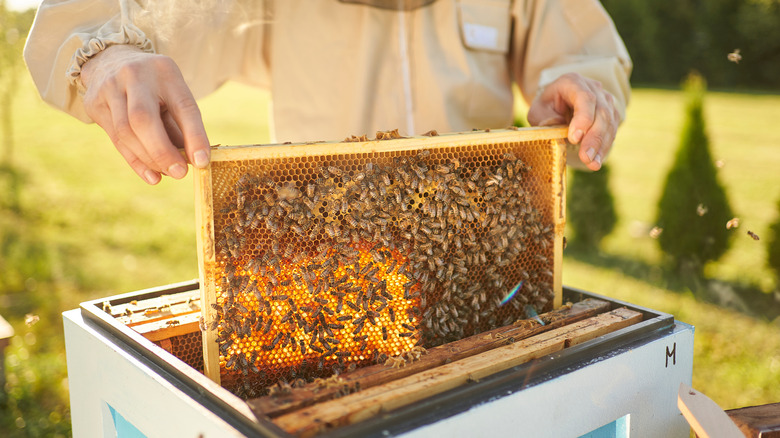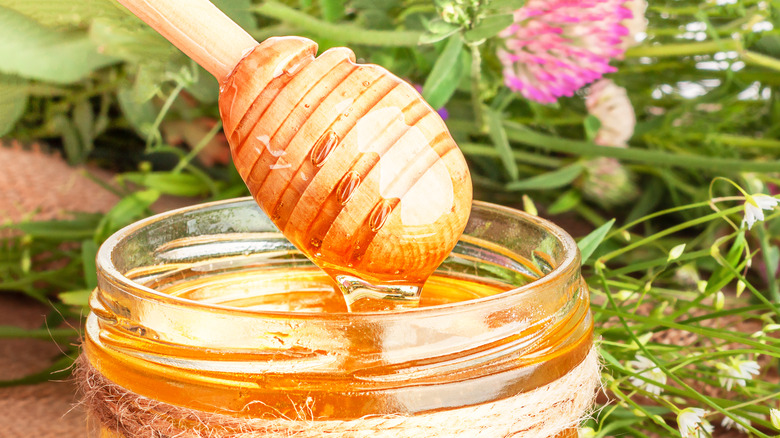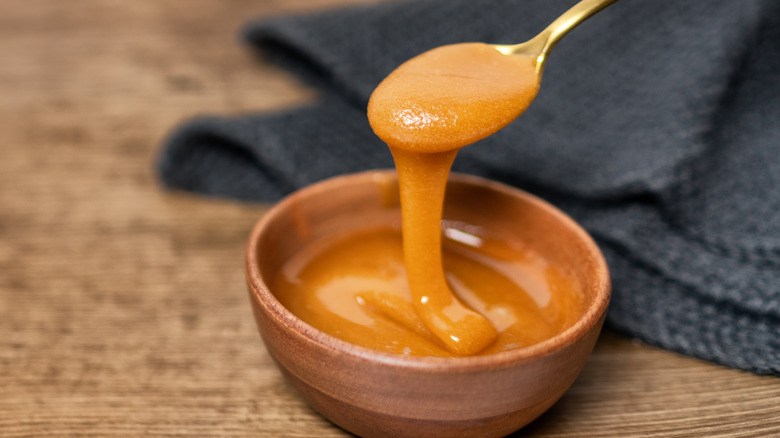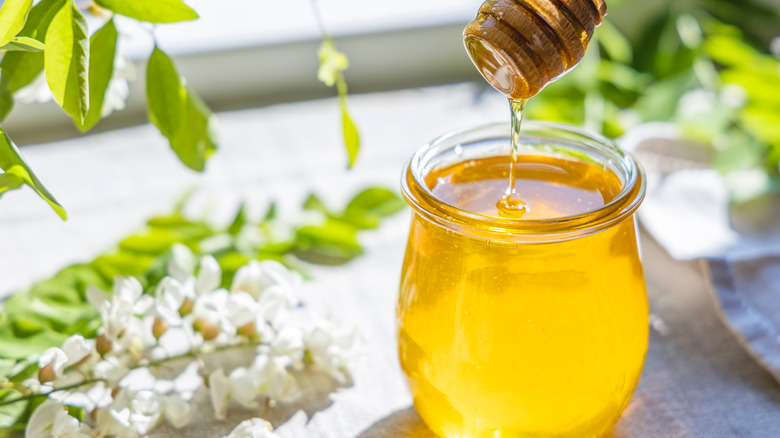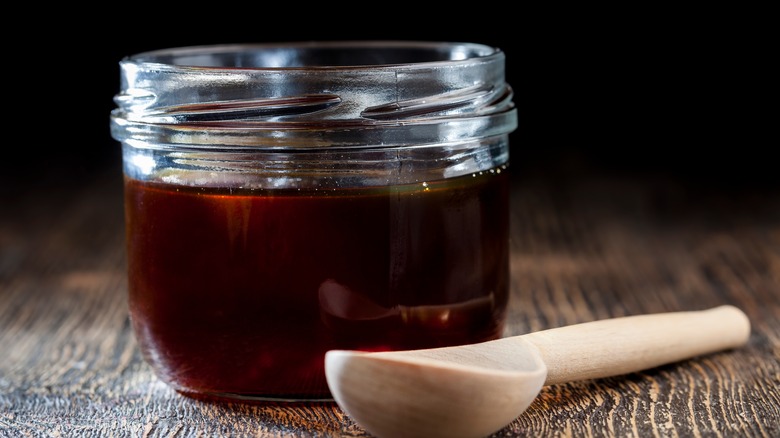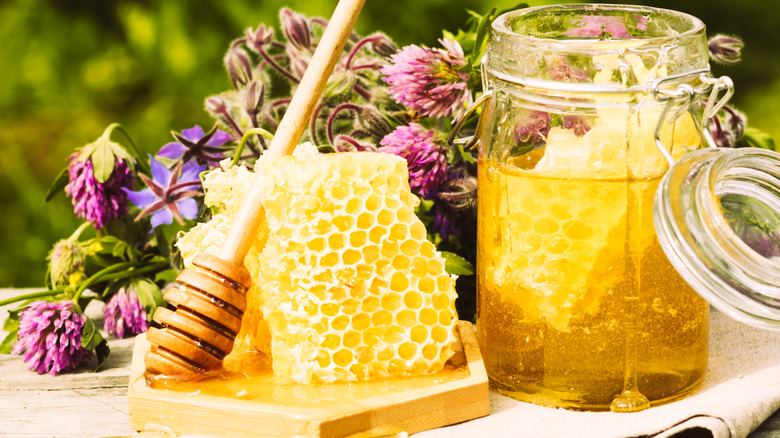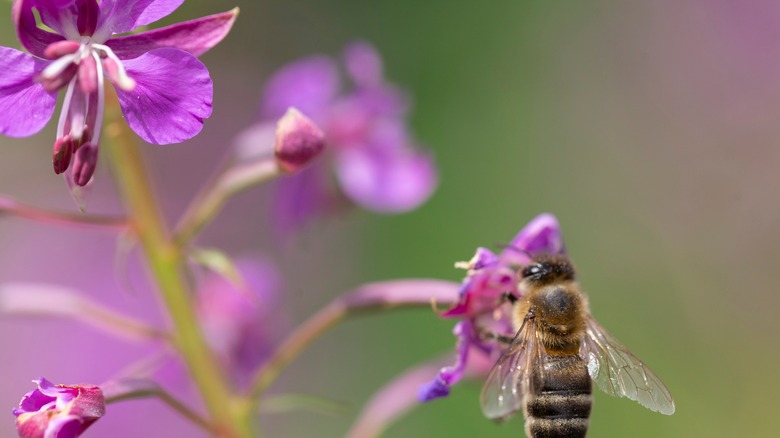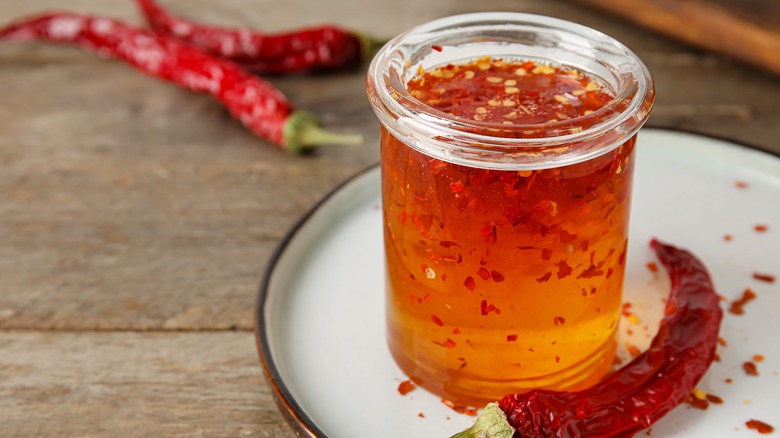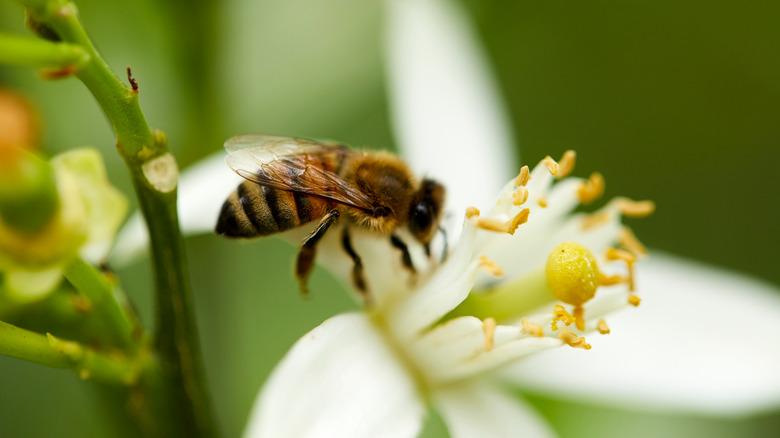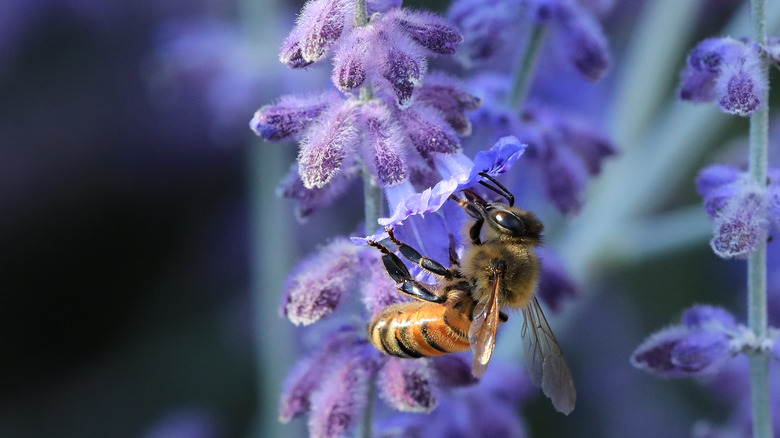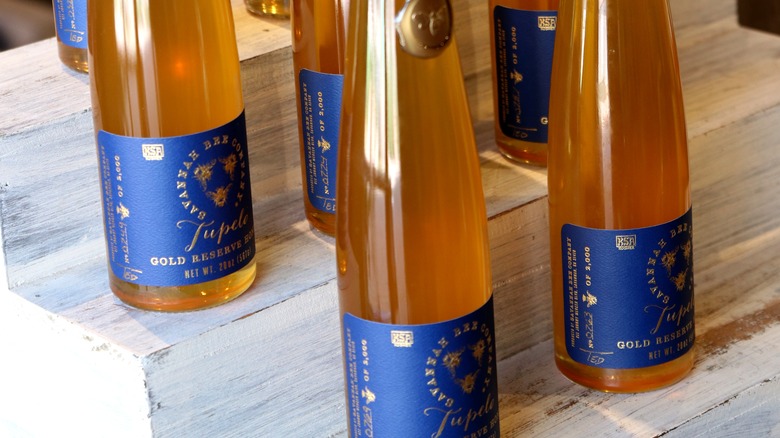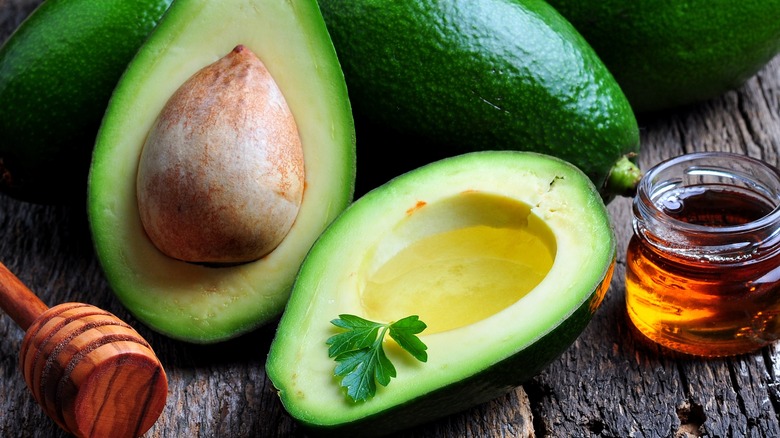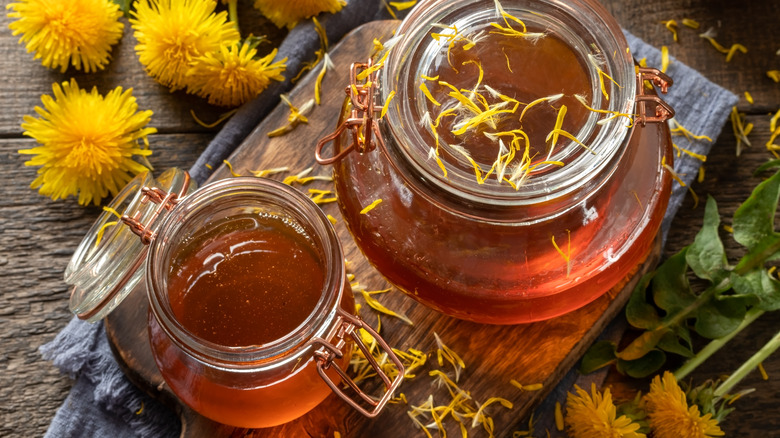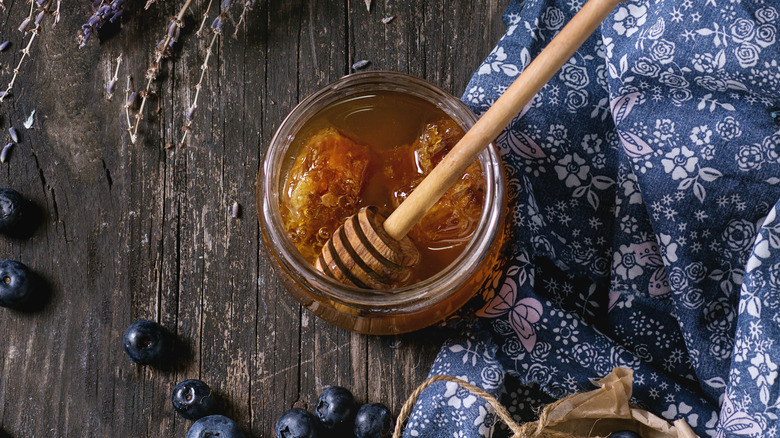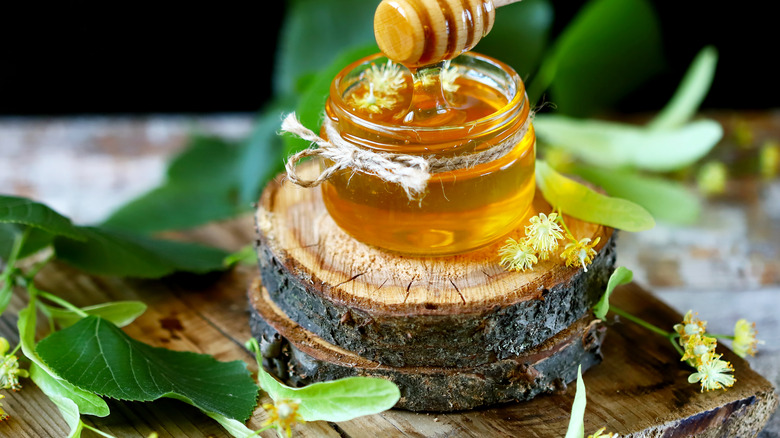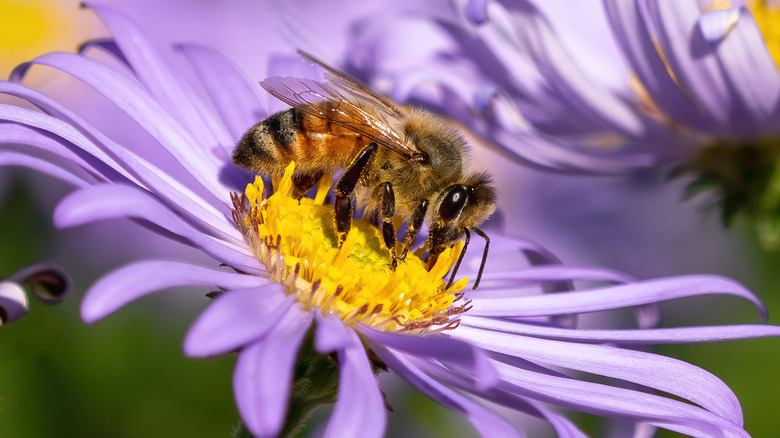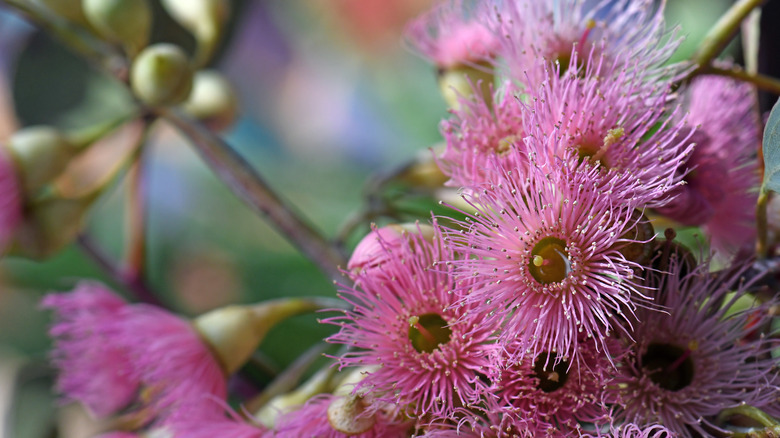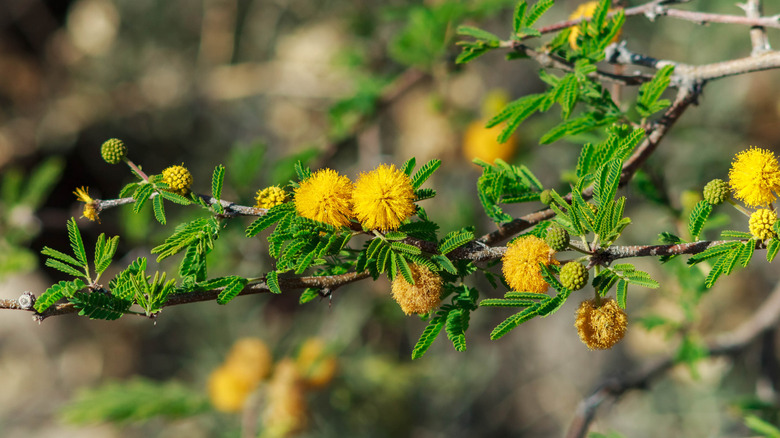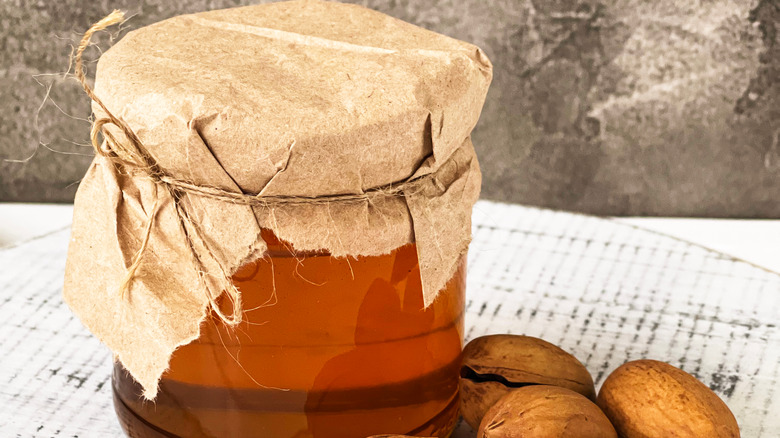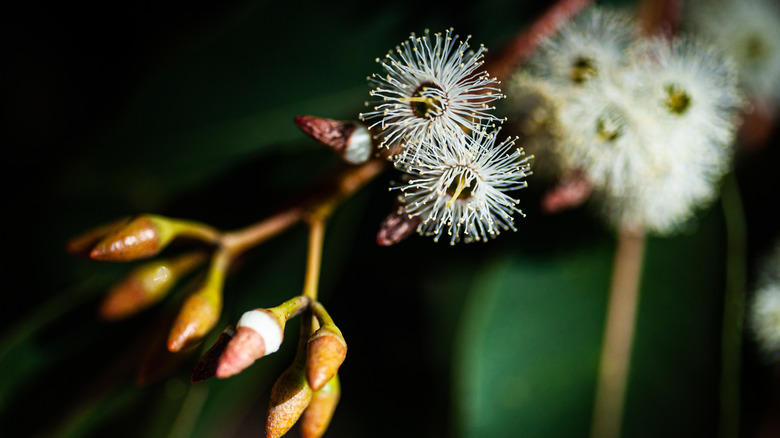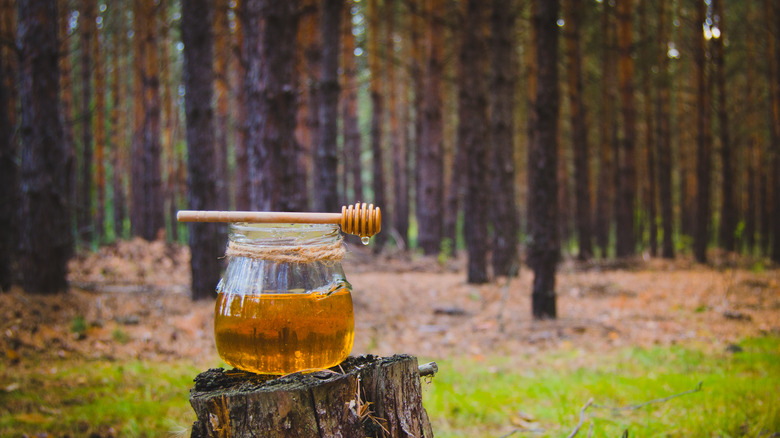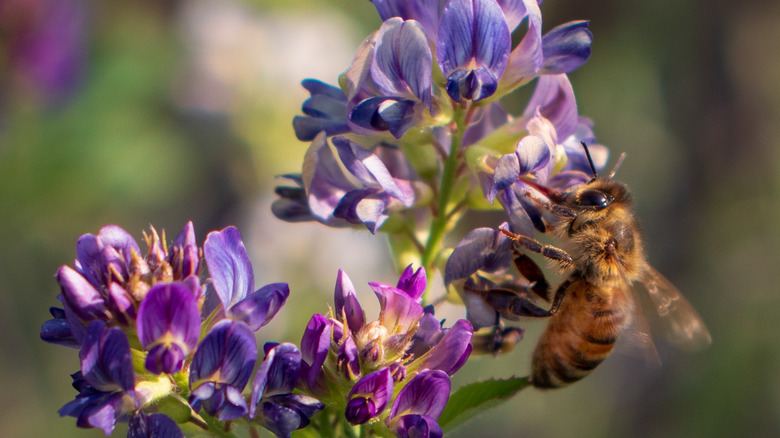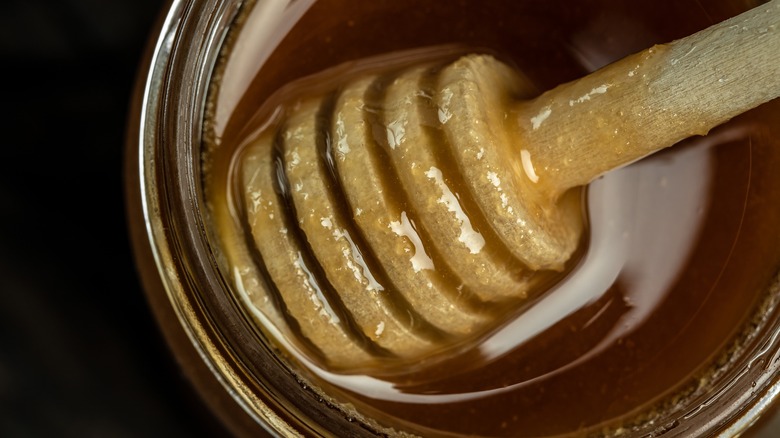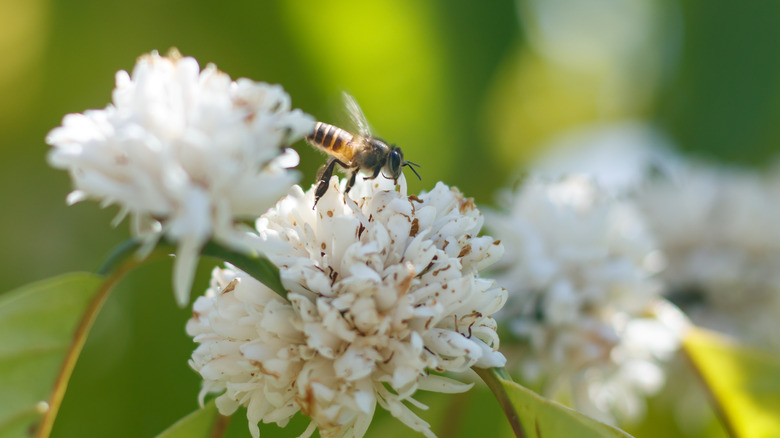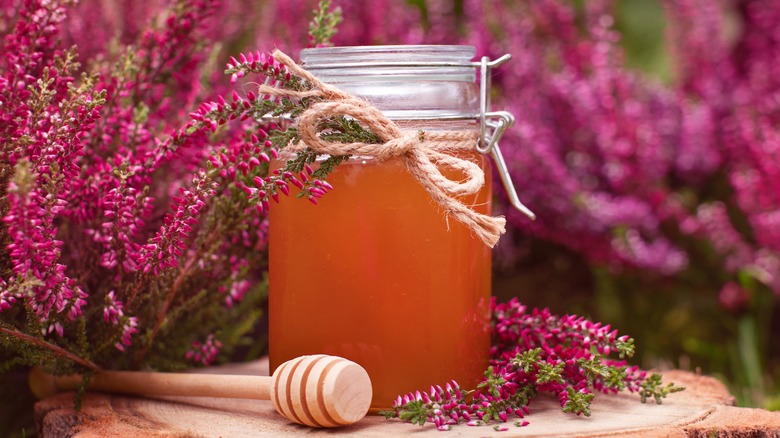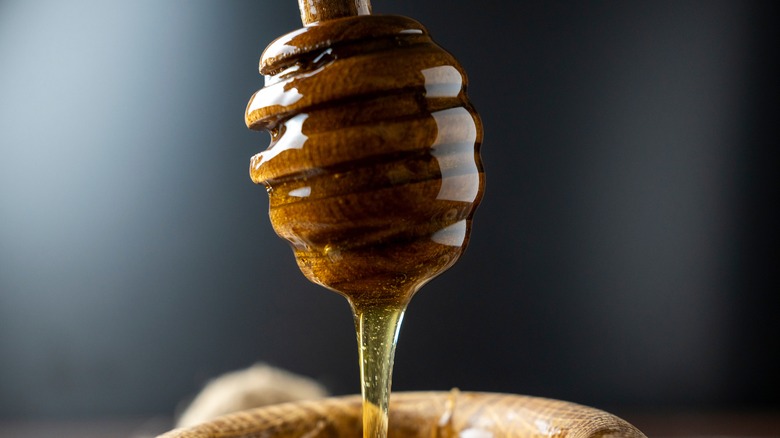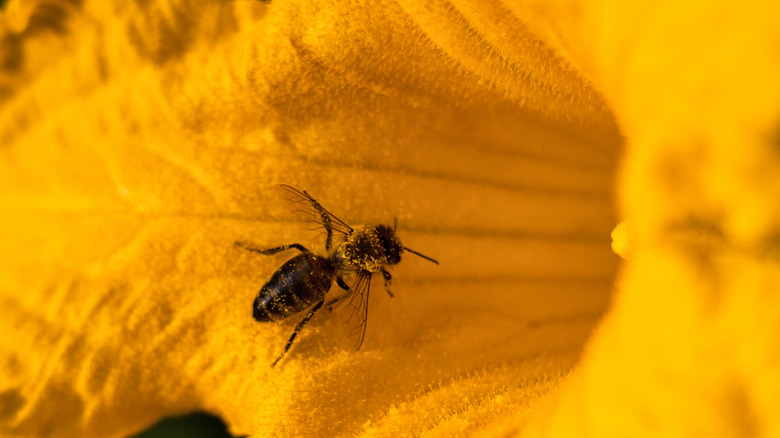26 Types Of Honey Explained
Yes, you read that number right: 26 types of honey. Who knew Winnie the Pooh's favorite snack had so many varieties?
So, what makes each honey different? There is a multitude of characteristics that set one honey apart from another, including the color and texture. There are also various ways of processing honey — like "raw" honey which isn't processed and thus includes more of the original pollen and minerals, or a pasteurized honey, which is a cleaner form of the honey and what you would use to brew beer.
The most basic difference, however, is which plant the nectar comes from. Each plant will contribute unique flavors, colors, and medicinal benefits. The only true way of knowing which honey you prefer is by trying them all — you could even bake them into desserts or mix them into marinades. Get a head start on figuring out which is your favorite by reading below.
Wildflower Honey
If you're thinking of stepping up your honey game, wildflower honey is probably the easiest one to get your hands on. Each bottle of golden syrup is a microcosm of fall and spring bottled up and preserved. Those gorgeous wildflowers dotting the landscape have kept the bees happy, and their honey makes us happy, too.
Typically a mix of flowers and flavors, wildflower honey is a subtle cacophony of floral notes. Because of the nature of wildflowers being, well, wild, each honey is dependent on the hive it comes from (via Heritage Bees). One beehive may be more herbaceous, and another could read more floral and sweet. Overall, however, wildflower honey is mild and sweet. Some variations may be better for mixing with beverages, while others — as Catskills Provisions points out — find their strength alongside sharp cheese on a charcuterie board. The fun is in exploring your options and discovering what notes of wildflower honey you prefer.
Manuka Honey
If there's one honey on this list we've heard a lot about, it's this one. According to Manuka Health, Manuka honey is collected from the Manuka tree during just a short few weeks in the summer. It is protected and beloved in New Zealand, and can only come from the North Island. In fact, there is a certification process all Manuka honey must go through before being recognized as such. UMF, the Unique Manuka Factor, has identified over 2,300 natural compounds in Manuka honey, all of which contribute to that iconic flavor, texture, and medicinal benefits.
According to UMF, Manuka honey is identifiable by its dark cream to dark brown color, as well as its mineral taste. Apparently what makes the honey so special is the plant itself. In Manuka plants, photosynthesis occurs both in the leaves — like normal — but also the nectaries, or where the nectar for honey is produced, as well. This gives the honey a potency not found in other varieties and is a reason it's so expensive.
Acacia Honey
Ironically, acacia honey does not come from bees who've pollinated an acacia tree. We know, how misleading. Instead, the honey comes from the false acacia tree, otherwise known as the black locust.
The resultant honey — whether in its pricier shape as a raw comb or nestled into glass jars — has a mild taste with hints of vanilla. This mild flavor makes it a favorite natural sweetener option, notes Maes Honey, as it isn't heavily nuanced and rather neutral. It is also incredibly light in color — almost translucent. Because of a higher fructose level, says the National Library of Medicine, this honey takes a long time to crystalize. That means it doesn't become grainy and solid after a while. Although crystallization doesn't affect the safety of your honey, it does change the texture and experience.
According to Healthline, acacia honey is high in antioxidants; most notably flavonoids, which is a plant compound with anti-inflammatory properties, says LiveScience. Whether you're a natural remedies skeptic or not, a spoonful of sugar certainly does go down smooth.
Buckwheat Honey
You've most definitely seen this honey in your local grocery store alongside the more recognizable iterations and thought, "like the flour?" Yep! You can have your bread and drizzle it with honey made from the same plant, too.
Buckwheat honey is primarily produced in Canada by bees that roam around Ontario and Quebec, and it is unforgettable with its dark color. According to GeesBees, the dark color comes from polyphenols, which are also found in red wine, dark chocolate, and some teas and berries. When it comes to honey, its color often relates to the overall flavor: Light honey will be light in flavor, while darker honey will have notes of caramel. But with buckwheat honey, you're going for the darkest honey you will find — its color ranging from purple to almost black, reports Healthline — and thus an almost bitter taste. However, that bitterness is rounded out by a nutty profile that makes this honey a sophisticated option.
Clover Honey
Another honey option you might have seen already and wondered what it is is clover honey. The nature of this honey is pretty much in the title: it's made from bees pollinating clover flowers. You know, those precious purple or white bulbs of flowers that pop up from the ground and look a bit like Horton's blossom.
According to Bee Hour, clover honey is one of the most popular honey varieties among consumers and is often actually considered the baseline — whether it is identified as clover honey or not. That's because bees simply love the flower. The honey itself is light in color, sometimes even white depending on the harvest, with a taste that is both mild and sweet. Some folks, including My Bee Line, have even mentioned a slight hay or grassy aftertaste.
Comparatively, clover honey does crystalize fast. So you'll want to use it quickly. Again, not much changes in the way of flavor, but the texture does limit its uses.
Fireweed Honey
Referred to as the "Champagne of honey" by Ashville Bee Charmer (and fans) thanks to its light color, smooth consistency, and bright taste, fireweed honey is an unusual specimen. The honey itself is a special treat — and not one you'll likely find at the grocery store.
Produced from a bright purple-pink wildflower of the same name, fireweed honey has a bit of a kick (via Flying Bee Ranch). There's not an intense level of spice, but it certainly is there. This might be because of where the fireweed plant gets its name: The U.S. Forest Service writes of its ability to quickly take over land recently burned by fires.
Much of the plant is edible — the leaves can be boiled into tea, its roots make a delicious spring vegetable, and it's highly medicinal, making it a historically beloved plant. And you know those tannins everyone talks about when it comes to wine? This honey has some as well, alongside a bunch of vitamins and antioxidants. The rest of the flavor is surprisingly (given the plant's hardy nature) light and aromatic.
Hot Honey
If we leave you with one thing, please let it be this: Hot honey is a masterpiece. Even just a drizzle of this stuff — most often from a bottle of Mike's Hot Honey — completely transforms and elevates your dish with a brilliant mix of sweet and spicy notes. Consider your pizzas forever changed.
There are multiple ways to make hot honey and various spices and peppers to play with. We like to combine dried Calabrian chiles with pasteurized honey. While most of the time honey comes in its raw form, it's not ideal when making hot honey. This is because the raw honey can crystallize when heated up, resulting in a grainy condiment that is not pourable at room temperature (which is kind of a necessity when it comes to hot honey). Simply heat your choice of honey and the dried chiles together, let it sit at room temperature for three days, and then use it to your heart's content. We swear you will never go back.
Orange Blossom Honey
According to The Beekeeper's Daughter, a family-owned honey store, orange blossom honey is the sweetest honey out there. Made from, you guessed it, the blossoms on honey trees (primarily in Florida), this honey has a distinct orange flavor, which means it is a wonderful addition to summer beverages. Can you imagine the lemonade you could make with this? That acidity from both the lemons and oranges is rounded out effortlessly by this bold flavor. In fact, some orange blossom honey is made with nectar from both orange and lemon trees, as the citrus trees are often found together (via Maes Honey).
Orange blossom honey is also great in BBQ sauces or drizzled or spread on anything you can think of! Medicinally, Pura Miel Cruda notes that orange blossom honey has a calming effect, and because of this, it is often considered a natural depressant and can be beneficial to those with insomnia, depression, or anxiety.
Sage Honey
If you thought the power of sage began and ended with the herb, you would be mistaken. In fact, the plant can produce honey as well. Farmers must allow the herb to blossom — or bolt — for bees to work their magic, notes Bees Wiki. But since most farmers want to harvest the sage itself, very few plants are left to transform as necessary for bees to harvest sage honey.
The honey itself comes from a variety of sage plants but is still considered mono-floral, or honey produced from one flower. According to Bees Wiki, sage honey is often a combination of black button sage, white sage, and purple sage. Honey Pacifica writes that sage honey is a favorite amongst chefs since it can sweeten dishes without leaving behind too much of a honey flavor. You can also try making your own honey infused with sage, writes the Herbal Academy, rather than honey sourced directly from the plant's nectar.
Tupelo Honey
The Slow Food Foundation for Biodiversity reports that tupelo honey is made from tupelo trees that thrive in Florida's remote wetlands, and is sweeter than most other varieties — just ask Van Morrison. In fact, it's quite a popular tag, with restaurants and clothing brands named after the stuff. So it must be good, right?
The tupelo tree blossoms only last two to three weeks, so this honey is a prized rarity. Tupelo honey is light in color, and fans compare the flavor to rosewater and cotton candy (via Slow Food Foundation for Biodiversity). But if you're not into overly sweet condiments, don't worry. Depending on the harvest, some tupelo honey is also known to have quite a hoppy aftertaste. Yum! In fact, according to Bees and Botanicals, tupelo honey is known as the "wine of honey" both because of its uncommonness and overall sweet taste. Beyond flavor, tupelo honey, like most honey, has medicinal benefits when both ingested or used topically (where it can protect against the sun thanks to high levels of Oxygen Radical Absorbance Capacity, or ORAC).
Avocado Honey
You might be asking yourself, "Does this really come from the same plant that produces the avocado I just had for breakfast smeared across my toast?" Yes, it does. Avocados need to come from somewhere, and those same trees just happen to bloom flowers that produce nutty honey. Avocados have long been added to desserts, but now you can add some sweetness to your meal without a strong avocado flavor.
Most avocado honey will come from California or Mexico, as seen in Temecula Valley Honey Company sources its from California and Rockland Honey's is from Mexico. This honey is dark in color and thus a bit bitter. Even though it's more on the bitter side, it still has that sweet honey flavor you know and love. According to Rockland Honey, thicker sweeteners like molasses or sorghum can be easily replaced with avocado honey. Not only is the texture similar, but the flavor is as well. This stuff can also be used in facials and, perhaps most interestingly, avocado honey makes a great antiseptic because of its chemical makeup, (via Bill's Bees).
Dandelion Honey
Hold on to your hats, and make sure you're sat down because we have some shocking news: Dandelion honey is not made from bees.
Dandelions are sort of a wonder plant. Nearly every aspect of them is edible, if not the whole plant. The roots have long been used to make tea that helps digestion, writes Healthline, the leaves can be cooked down just like spinach or kale, and the flowers can be used for a variety of things — in this case, honey. The Almanac website first refers to dandelion honey as a syrup, which is ultimately true. No matter what recipe you use, you will ultimately be boiling a considerable amount of dandelion flowers with sugar, water, and some lemon juice. The end product will be a deliciously sweet yet floral honey/syrup that belongs on top of everything all the time. All we have to say is it's time to get foraging in your backyard!
Blueberry Honey
Let's get one thing straight: Blueberries are a top-tier fruit. This honey, blueberry honey, is another way to celebrate this quintessential summertime snack. And while you may be thinking that this is an infused honey, we would like to assure you it is not.
Raw blueberry honey comes from the bushel's small blossoms, notes Backyard Beekeeping 101. The resulting treat has a well-rounded flavor that reflects its surroundings and acidic soil. Brock University, a college in Ontario, Canada, analyzed the bacteria-killing activities of eight kinds of honey, including blueberry honey, and found it highly effective. What is really important, however, is the taste. Blueberry honey can vary depending on the bushels and where they are grown, but, ultimately, the honey is a light amber color with a full-bodied, slightly fruity flavor (via Honeyview Farm). Does anyone else immediately have the desire to eat blueberries with blueberry honey now?
Linden Honey
Linden honey comes from, you guessed it, linden tree blossoms (via Honey Traveler). These flowers are basically cat-nip to bees; the delicate white flowers result in light-colored honey that has a shocking intensity of flavor. Typically with honey, the darker it is, the bolder the taste. Here, however, you'd be shocked to find that the color is misleading. Even more so if you are lucky enough to be around linden honey when it's fresh. According to Honey Traveler, the honey is fresh and almost woodsy, yet still has a medium sweetness and a slight bitterness despite being low in acidity.
Medicinally, American Raw Honey notes that linden honey is also antibacterial, which makes it a great option for treating coughs. Swallowing the honey coats the sore throat for a momentary release while those vitamins and antioxidants get to work. Even Mount Sinai has a website page devoted to the linden tree and its many health benefits.
Aster Honey
While asters come in many sizes and colors, the Montgomery County Beekeepers Association writes that honey bees are partial to the bright purple and wild white asters that you can see dotting the ground in the fall. UC Davis Bee Haven notes the flowers bloom through November and are a key source of late-season pollen. According to North Dakota State University, asters help bees stock up on the food they need to survive through winter.
Aster honey is often a mix of nectar from asters, as well as goldenrod, which rounds out the flavor and gives aster honey its color (via Bees Wiki). One thing to note, however, is that this particular mix of flowers can result in smelly honey, notes the Honey Bee Suite. Don't worry if your batch does, nothing has gone rancid. According to the Honest Beekeeper, aster nectar just has a powerful aroma. The flavor, however, will not be affected. If you're interested in trying aster honey for yourself, check out your local farmers' market or natural food store!
Ironbark Honey
This honey comes from down under! Ironbark wood is native to Australia, where it's been used since the dawn of human history. According to Bayswood Timber, indigenous communities used the wood to make throwing spears, as well as boiled the bark to treat wounds. Ironbark blossoms are fascinating to look at. They are bright pink, and instead of petals, the flower is made up of hundreds of stamens making the blossom look like something out of a Dr. Seuss book.
The honey from ironbark tree blossoms is light in color with a delicate flavor profile that is almost buttery (via Beechworth Honey). According to Australian by Nature, ironbark honey contains several vitamins — including ascorbic acid, most commonly known as Vitamin C, which your body uses to form blood vessels and collagen for bones — and is a highly concentrated source of essential nutrients. Because of its delicate flavor profile, ironbark honey makes a great natural sweetener alternative. Be careful though, this one crystallizes quickly!
Blue Gum Honey
No, we're not talking about honey made from sour Hubba Bubba. Trees of Stanford writes that the blue gum tree, better known as eucalyptus, is a tall, evergreen tree native to Australia. Just look up an image of the trees online to see them all lined up in rows — it's mesmerizing.
Blue gum honey may not be immediately recognizable to us, but for folks from Australia, it's a very popular variety (via GoToChef). This honey is distinct in flavor thanks to the eucalyptus flower's nectar, which influences the fruity flavor. Some varieties have an almost menthol-y aftertaste that some people find refreshing. When it comes to blue gum honey, Beechworth Honey says to keep it simple: Spread some over toast and call it a day!
As for medicinal benefits, Nature Word notes that blue gum honey contains hydrogen peroxide, which makes it a great antibacterial option. The honey has also been used to treat urinary tract infections. And, of course, like many other honey variants, to treat colds and the flu.
Macadamia Honey
This specific flavor of honey recently went viral after Trader Joe's released their own "Hawaiian Macadamia Nut Blossom & Multi-Floral Honey." Fans began raving about its nutty flavor online, saying they added it to matcha lattes and morning tea for a fresh take on a traditional ingredient. According to reviewers, it also makes a fantastic addition to charcuterie boards, especially if you're going the French route and having one for dessert.
Native to Hawaii, macadamia honey's balance of nuttiness and sweetness also makes it the perfect addition to a cup of ice cream (via Big Island Bees)! It has a dark amber color, so you know the flavor is going to be a bit more intense than its lighter counterparts. It's rich and velvety, reminiscent of caramel — which makes it a great alternative for ingredients like molasses. People also find that the macadamia flavor does carry over, giving the sweetness a tropical tang, according to Rare Hawaiian Honey.
Jarrah Honey
As reported by Jarrah Honey Info, jarrah honey comes from a different kind of Australian eucalyptus tree that is slow-growing and can live up to 1,000 years, which doesn't say much about the flavor of the honey but it is quite interesting to know! The honey itself is highly researched for its medicinal benefits, primarily its antibacterial and antimicrobial properties. In fact, according to Jarrah Honey Info, jarrah honey has one of the highest antioxidant levels in the world. That means it could be an invaluable addition to your diet. And if you struggle with mouth ulcers or bad breath, according to Jarrah, jarrah honey can help you in that area, too.
Flavor wise, jarrah honey is reminiscent of caramel in both texture and taste. Because it is high in hydrogen peroxide (thus its antibacterial effects), some people describe the flavor as being antiseptic. But before you go ahead and sign this honey off, know that Jarrah honey has a higher fructose level than most, so the sweetness balances everything out.
Pine Tree Honey
Famously from Greece, as described by Reuters, pine tree honey is a heralded delicacy from the gorgeous island's forests. In fact, it makes up 60% of the honey production in Greece. They are, however, under threat of increasing wildfires. The rampages danger the hives and the trees they rely on to survive.
According to Odysea, the honey is extracted cold and barely filtered to ensure the maximum retention of beneficial properties. The honey is, appropriately, delicious with Greek yogurt — whether eaten with just those two ingredients or combined with fresh fruit and granola. Pine tree honey has a slightly salty aftertaste that will transport you right to the oceans of Greece. It does, however, stay true to its forest origins with a woodsy flavor, writes The Olive Table. It is also rich in amino acids with fewer calories than other honey. Pine tree honey is resistant to crystallization, so you can take your time savoring this one without worrying about a dramatic change in texture.
Alfalfa Honey
When we think of alfalfa, we think of sprouts. Did you know you can also get honey made from the plant? Alfalfa honey is mild, floral, and light (via Hive Brands). The bees are attracted to the plant's purple blossoms that look almost like a cross between asters and thistles.
The honey made from an alfalfa plant is the perfect accompaniment to dishes without taking over the flavor. However, Bees Wiki notes this honey is difficult for bees to produce, and thus remains a specialty in the honey world. Raw alfalfa honey can be added to sauces and salad dressings, marinades, and simply as a drizzle over cheeses, writes Amish Honey. It also crystallizes slowly given its lower fructose level.
If you're into brewing beer at home, according to Brew Your Own, you can add alfalfa honey to beer since it's mild in flavor. But if you do choose to use the honey for brewing beer, you'll want to make sure it's pasteurized and not raw.
Sourwood Honey
There's nothing quite as beautiful as when the weather turns and the leaves change. You look out the window and the whole world is aglow. If you're lucky, there amongst the oranges and yellows will be a tree with bright red, almost neon, leaves that seem to radiate out from the others. That would be a sourwood tree.
Besides being drop-dead gorgeous, this tree also produces delicious honey. According to the honey experts at Asheville Bee Charmer, sourwood honey is a highly sought-after and favored variety for its amber color and mixed flavor profile. The honey is delicate without compromising depth, with some producers — like the Appalachian Beekeeping Collective — citing characterizing notes of anise and spice. Despite "sour" being in its name, sourwood honey is not. Rather, it has a texture and flavor similar to caramel. All of these characteristics make it highly beloved by chefs, who enjoy playing with the nuttiness, moderate acidity, and hints of stone fruit.
Coffee Honey
As if we need more ways to inject coffee into our bloodstream! Coffee honey can come in one of two forms. It is either similar to dandelion honey, where you boil coffee grounds with water and honey to form one new ingredient, or you can find coffee honey made from coffee blossoms from somewhere like Coffee Blossom Honey.
Coffee honey showcases the beneficial relationship between plants and bees. The coffee plants need bees to bear fruit, and the bees need the tree's blossoms to gather food and make delicious honey for us to enjoy. The resulting honey is amber in color with a medium sweetness that has hints of apricots, notes Smiley Honey Co.
And if you're looking to try some yourself, make sure to type "coffee blossom honey" or "coffee tree honey" into the search engine. Otherwise, you will just come up with recipes for honey in coffee — which is a delicious alternative to processed sugar, but not exactly what you're looking for.
Heather Honey
Heather plants like to dot rolling hills, their long stems and bell-shaped purple flowers casting waves with the wind. Honey Traveler writes that heather honey is rare thanks to a short blooming season. Heather honey is produced by bees who pollinate one of two distinct types of heather plants: either a true heather plant, the Ling heather, or any variety from the Erica species.
The honey made from Ling heather plants is gel-like with a property called thixotopism. It will temporarily become liquid when agitated, so stir it a bit before spreading some over toast or adding it to your tea.
According to Saveur, collecting heather honey is a protected craft in Scotland that dates back for centuries. The honey is beloved for its intense flavor that is earthy and, depending on the time of harvest, quite smoky. Fans refer to it as the "Rolls Royce" of honey and it is now highly regarded as a superfood (via The Scotsman Food & Drink).
Beechwood Honey
Also known as honeydew honey, beechwood honey is a gorgeous dark amber color with flavor notes of berries (a bit unusual for honey) and caramel, writes Mountain Valley Honey. Rather than sourced from a flower's nectar, Science Learning Hub writes that beechwood honey is collected from beech scale insects' sap. Yeah, that is a little upsetting to hear, but it means the resulting honey is surprisingly low in pollen — if that's something you're sensitive to. According to The Honey Bee Store, beechwood honey's mineral content is the highest of all kinds of honey.
So what are beech scale insects, and how do we collect their sap? The politest way to say this is that the insects collect sugar from the beechwood tree's leaves but often eat too much. When it does, the insect then, you know, lightens its load. The excess sugar forms droplets of sap along the bark of the beechwood tree, which are then collected for our consumption (via Science Learning Hub).
Pumpkin Blossom Honey
If you've ever grown pumpkins yourself or wandered into a patch pre-fertilization, you will inevitably stumble upon massive yellow flowers similar to those found on zucchini or summer squash plants. They're soft and warm — as if you could dive right into them. Luckily, the bees feel the same, writes Honey Gramz.
Much like the symbiotic relationship between plants and bees really showcased with coffee honey, the same can be said here. According to Bee Culture, pumpkins and squash rely on native squash bees. Perhaps because the bees are squash-specific, when we get to enjoy delicious pumpkin blossom honey it does in fact taste like squash. Most honey won't bring flavors from their source plant with them, but pumpkin blossom honey definitely does.
Given its flavor, pumpkin blossom honey lends itself to dishes built around squash. For instance, you can add it to pumpkin-based desserts around the holidays for a well-rounded, earthy flavor from start to finish.
